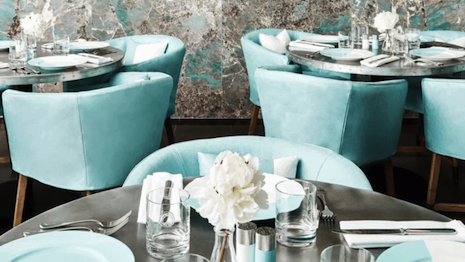 Tiffany & Co.'s Believe in Love campaign. Image credit: Tiffany & Co.
Tiffany & Co.'s Believe in Love campaign. Image credit: Tiffany & Co.
CAPE TOWN, South Africa – With a history spanning almost two centuries and two continents, U.S. jeweler Tiffany & Co. is staying relevant to younger consumers through initiatives that speak to their values, without rejecting its roots.
In a conversation between Vogue International editor Suzy Menkes and the CEO of Tiffany & Co. at the Condé Nast International Luxury Conference on April 10, the pair discussed how the jeweler’s connections to New York and Africa shape the brand. As Tiffany & Co. continues to connect with younger affluents, it must balance its heritage with appreciation for sustainability and self-expression.
“The spirit of every brand is different,” said Alessandro Bogliolo, CEO at Tiffany & Co., New York. “The fact that Tiffany & Co. is a brand that has a DNA that is truly New York and American, that’s a big difference from European brands where the DNA is more traditional, with an approach that’s more exclusive, more formal.
“When it comes to Tiffany, it’s a brand that’s all about refinement, but a refinement that’s understated and more inclusive,” he said. “I think inclusive in the sense of really being more informal, more joyful.
“We tend to be a brand that smiles more. It’s a different attitude that at the end of the day comes from DNA and brand spirit, and the whimsical spirit of New York.”
Tiffany tales
The luxury goods and jewelry industries have changed significantly since Tiffany was founded in 1837.
For instance in 1861, U.S. president-elect Abraham Lincoln went to Tiffany in New York to purchase pearl jewelry as an inauguration gift for the future First Lady Mary Todd Lincoln.
Tiffany’s Blue Box Cafe at its New York flagship. Image credit: Tiffany & Co.
Mr. Bogliolo also discussed how in the period following World War II, New York was thriving and the brand’s designers turned to nature for inspiration. This translated into colorful and cheerful jewelry.
The classic 1961 film “Breakfast at Tiffany’s” has also introduced generations of customers to Tiffany diamonds.
More than five decades after it premiered, the movie inspired Tiffany’s Blue Box Cafe. The brand’s first dining concept brings the dream of having breakfast at Tiffany to life (see story), and Mr. Bogliolo admitted it has proved to be more relevant among younger consumers than he initially anticipated.
Another recent change in the jewelry world is the growth of self-gifting. More female consumers are purchasing their own jewelry as a way of expressing themselves.
Similarly, Chinese consumers – a crucial segment for Tiffany – are increasingly empowered financially and shopping for themselves.
“I think this [self-expression] is relevant for everyone,” Mr. Bogliolo said.
Many Tiffany pieces can be personalized. Image credit: Tiffany & Co.
To indulge the contemporary desire for individuality, the jeweler is encouraging consumers to make its designs their own by using the brand's personalization services. Although Tiffany has been offering personalization on its jewelry and accessories for more than a century, the brand recently shared both tongue-in-cheek and sentimental personalization options to capture the imagination of a wide audience of shoppers (see story).
“On one side you have to be faithful to your DNA,” Mr. Bogliolo said. “But on the other side, you have to keep that DNA relevant for the new generations.”
Tiffany in Africa
Another key component of Tiffany’s DNA is craftsmanship.
“Craftsmanship is the common denominator of luxury, regardless if you are an American or if you are a European brand,” Mr. Bogliolo said. “The best brands in the world really master craftsmanship when it comes to jewelry making, specifically for us the craftsmanship that has to do with diamonds.”
Although Tiffany has close ties to New York, the jeweler’s connection to Africa is also tangible. The company has two locations on the continent, and employs hundreds of high-skilled workers.
Mr. Bogliolo shared that he planned to personally meet with workers in Botswana, who he described as the “essence of the brand,” following the conference. Reflecting the brand’s commitment to corporate responsibility, these artisans are paid a living wage.
Tiffany also has consumer-facing initiatives that publicly show its support for wildlife conservation, sustainability and transparency.
As a member of the U.S. Wildlife Trafficking Alliance, Tiffany has launched several campaigns relating to the conservation of wildlife. The #TiffanySaveTheWild collection features a number of animal and wildlife-inspired designs, particularly an elephant charm and an 18-karat gold elephant clip (see story).
The U.S. jeweler has taken a large step in revealing where its diamonds come from in an effort to be more transparent with its customers and better serve the ethical-focused consumer of today.
Tiffany & Co. is taking its commitment to sustainable sourcing a step further by disclosing the origins of its newly sourced diamonds to customers. Through social media and greater product details in addition to more ethical services rolling out in the future, Tiffany is hoping to solidify confidence for customers when purchasing with its brand (see story).
“Tiffany is unique among jewelers in acquiring diamonds directly from the source, from mines that are known and responsibly managed,” Mr. Bogliolo said.


